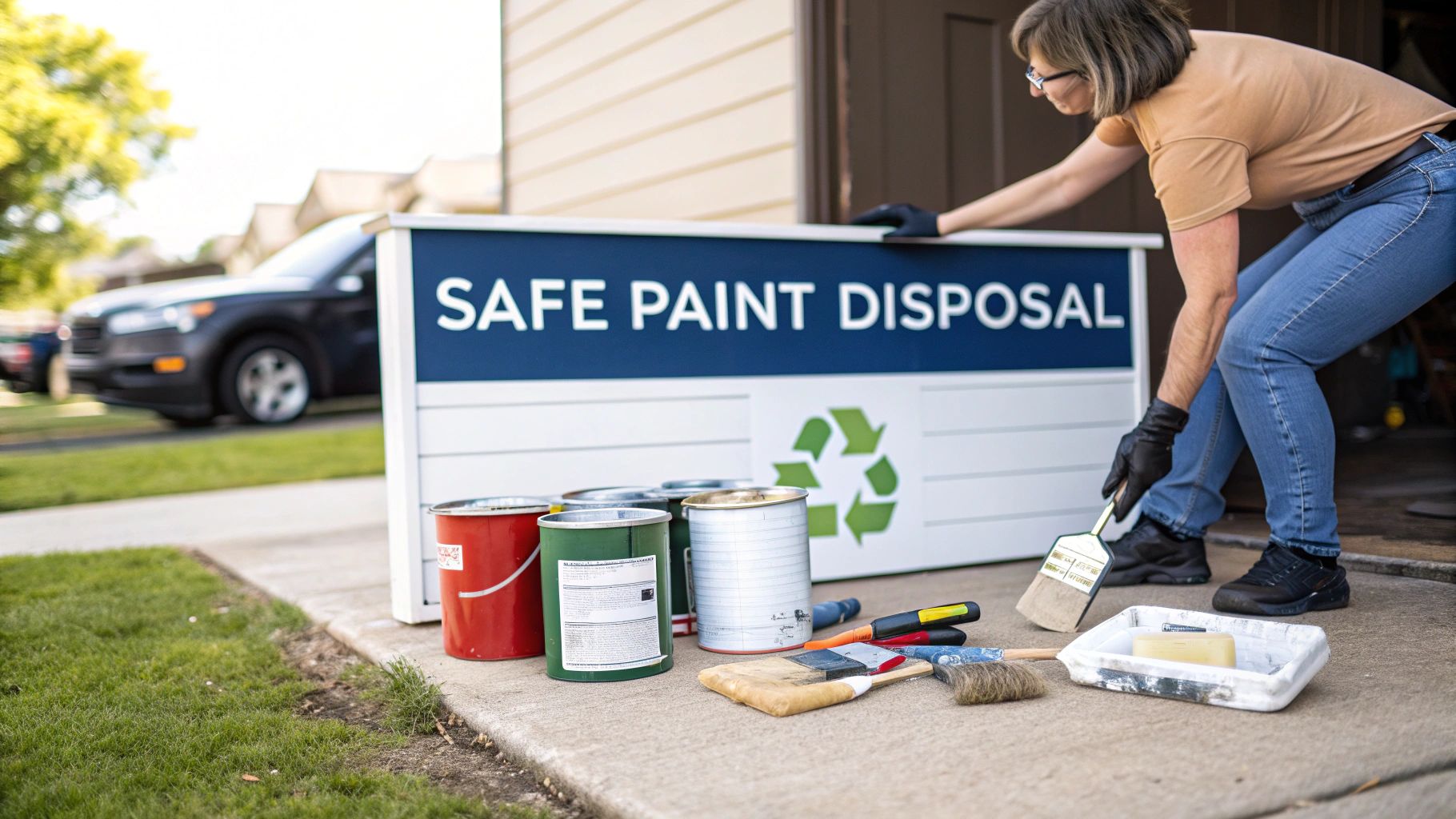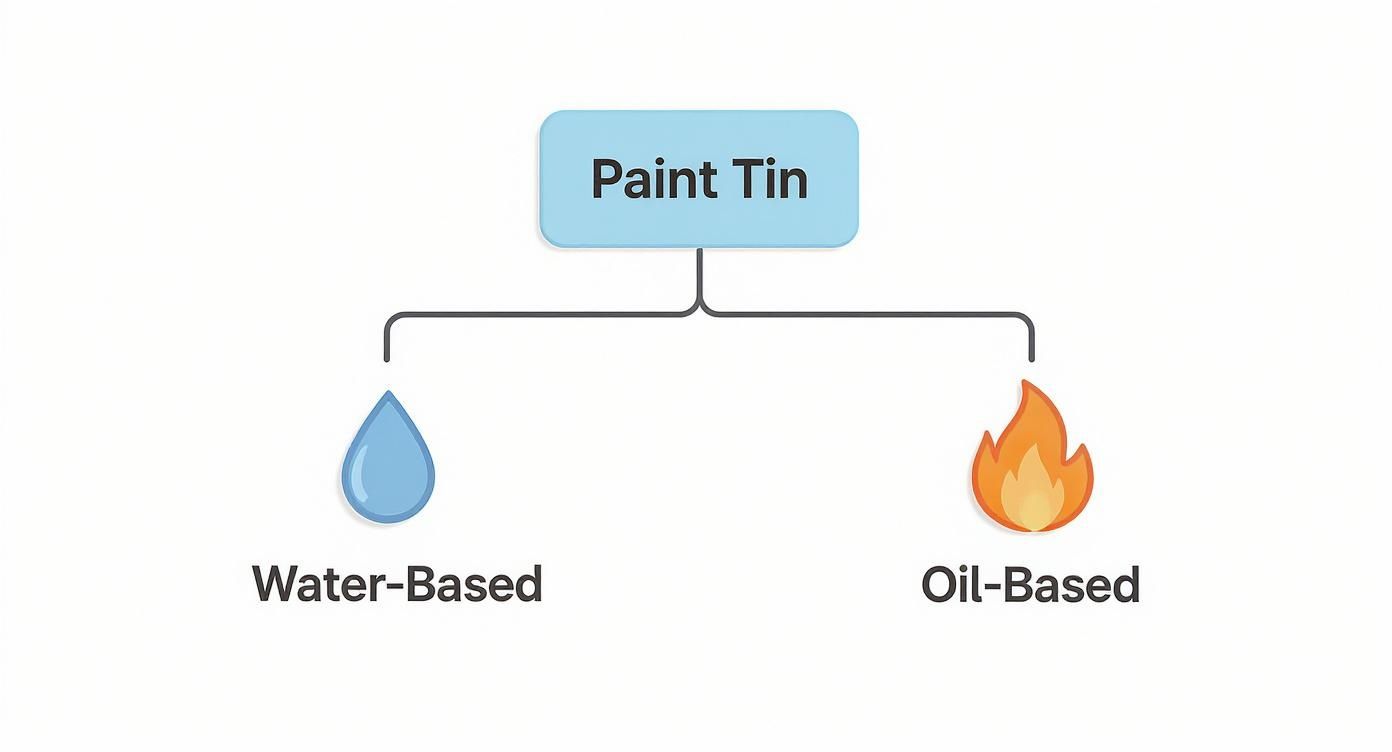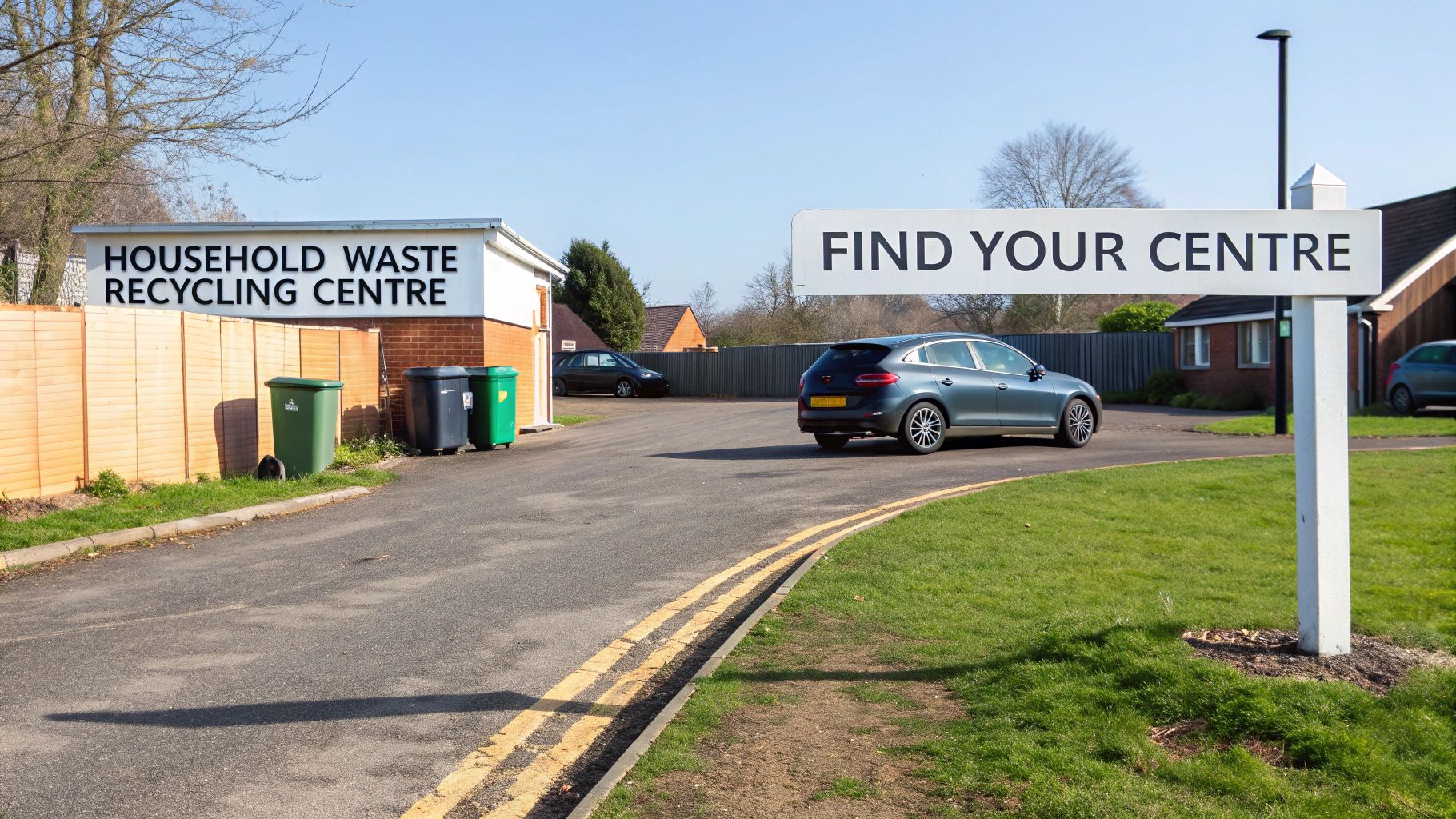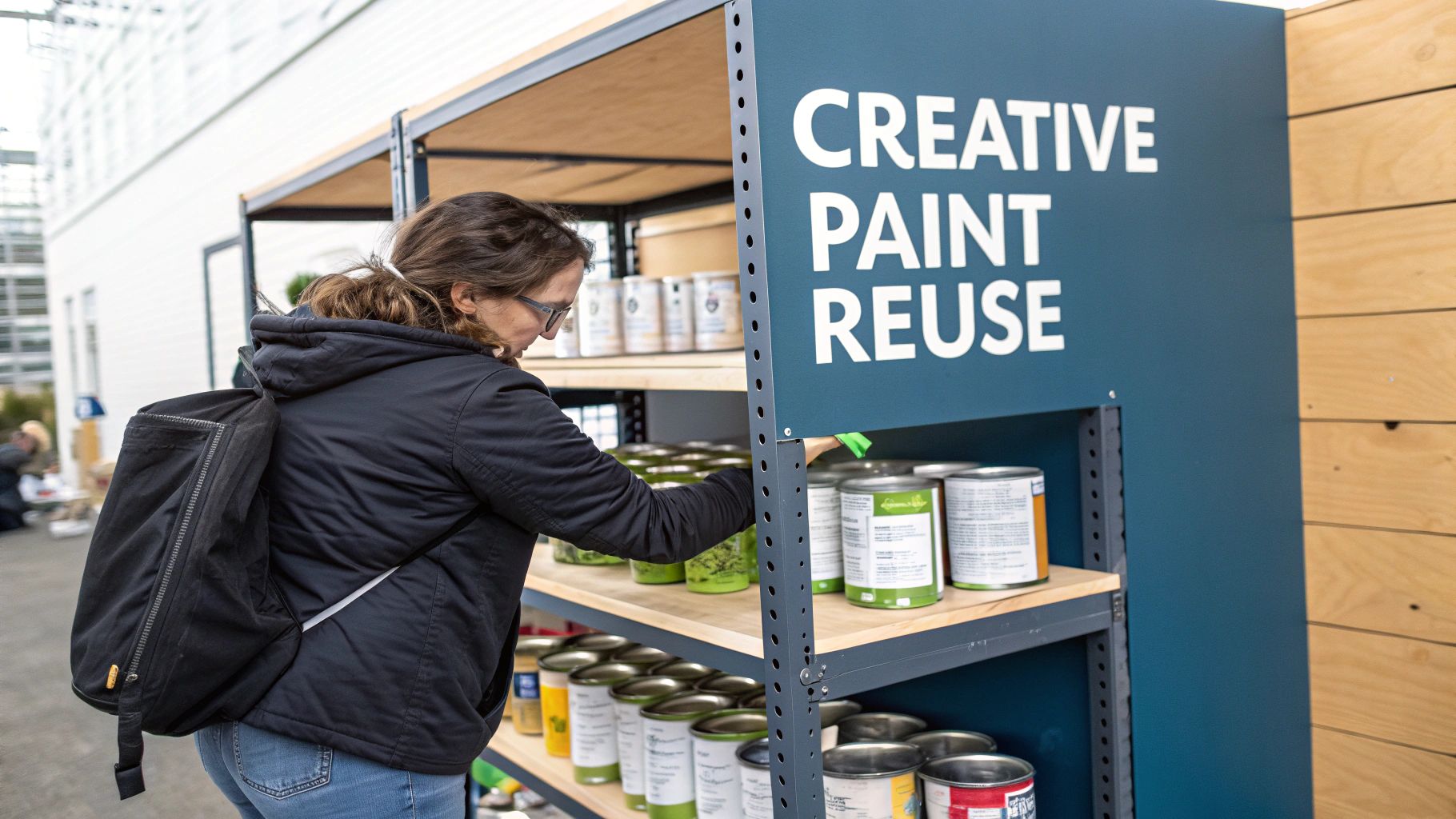How dispose of paint: UK guide to safe disposal

How dispose of paint: UK guide to safe disposal
So, the decorating is done, and you're left with a collection of half-empty paint tins cluttering up the garage. We've all been there. But what's the right way to get rid of them? It can feel like a bit of a minefield, but it's actually quite straightforward once you know the rules.
This guide will walk you through exactly how to dispose of leftover paint safely and legally here in the UK, without causing a headache for yourself or the environment.
The first, and most important, step is to work out what kind of paint you're dealing with. Is it a common water-based emulsion or a tougher oil-based gloss? This single detail changes everything about how you should handle it.
Whatever you do, don't be tempted to pour it down the drain. This is illegal in the UK and for good reason—it causes serious blockages and pollutes our waterways. Getting it right from the start saves a lot of hassle down the line.
UK Paint Disposal Options at a Glance
To make things simple, here’s a quick reference table. Use it to quickly check the correct disposal method based on your paint type.
| Paint Type | How to Identify It | Correct Disposal Method | Can It Go in Household Bins? |
|---|---|---|---|
| Water-Based Emulsion | Labels say "water-based," "latex," or "acrylic." Cleans up with soap and water. | Must be fully hardened first. Mix with cat litter, sawdust, or sand. | Yes, but only once it's completely solid. |
| Oil-Based Gloss/Solvent | Labels say "oil-based," "solvent-based," or "alkyd." Requires white spirit to clean. | Must be taken to your local Household Waste Recycling Centre. | No, it's classed as hazardous waste and cannot go in household bins. |
This table covers the basics, but it's worth understanding why these rules are in place.
Why You Can't Just Tip It Away
It's easy to think that if emulsion paint cleans up with water, it must be harmless to pour down the sink. That’s a common mistake. This type of paint is full of microplastics and other chemicals that clog pipes and cause real damage to aquatic life.
The rule of thumb is simple: If you have a small amount of emulsion, you must harden it completely before it goes anywhere near your household bin.
When liquid paint of any kind makes its way into a landfill, those chemicals can seep into the ground, contaminating the soil and our water supplies. This is precisely why local councils have such strict rules, and why your local tip has a special area just for hazardous materials like oil-based paints.
Proper disposal isn't just about the paint in the tin, either. It extends to your tools. A big part of the process is learning how to clean paint brushes responsibly to avoid washing harmful residues into the water system. By taking a few simple, correct steps, you're doing your bit to protect the local environment.
Identifying and Preparing Your Leftover Paint
Before you can figure out the best way to get rid of leftover paint, you need to play detective. What exactly is lurking in those half-used tins at the back of the shed? This is the most crucial first step, as it determines whether you're dealing with standard household waste or a hazardous material that needs special attention.
The best clue is right there on the label. Most manufacturers make it pretty clear what you’re working with.
- Water-Based Paint: You'll probably see this called emulsion. Look for terms like "water-based," "acrylic," or "latex." The dead giveaway is usually in the clean-up instructions – if it says to just use soap and water, it’s water-based.
- Oil-Based Paint: This covers most gloss paints, varnishes, and speciality wood or metal paints. The label will likely say "oil-based," "solvent-based," or "alkyd." If it tells you to use white spirit or a specific brush cleaner, you’ve got an oil-based paint.
This simple sorting process is your starting point.

As you can see, the first job is to split your paint tins into two piles: water-based and oil-based. Their disposal routes are completely different.
Check if the Paint Is Still Usable
Hold on before you head to the tip! It's always worth checking if the paint can be rescued. Paint that’s been sitting for a while hasn’t necessarily gone bad, and saving it means less waste and more money in your pocket for the next project.
Pop the lid open with a screwdriver. The first test is your nose. If it smells sour or rancid, it’s definitely past its best and needs to be disposed of.
However, if it just looks a bit separated with a watery layer on top, that’s completely normal. Grab a stirring stick and give it a really good mix for a few minutes. If it combines back into a smooth, even consistency without any hard, gritty lumps, it’s almost certainly fine to use.
Here's a quick pro-tip: brush a little onto a piece of cardboard. If it dries smoothly without cracking or peeling, you're good to go. You’ve just saved yourself a tin of paint!
Prepare Your Tins for Safe Disposal
Once you’ve sorted what’s usable from what’s not, a little bit of prep makes the whole disposal process much safer and easier. This is especially important if you’re driving the tins to a local recycling centre. Taking a few minutes to get organised now will save you a headache later, and our complete guide on how to get rid of paint has more detailed tips on local rules.
First, if you have several half-empty tins of the exact same type and colour, combine them into one. It makes no sense to haul three nearly empty tins when you can just take one full one. This simplifies things for you and for the staff at the recycling facility.
Next, make sure every lid is on tight. If an original lid is bashed up or won't seal properly, put a layer of cling film over the opening and then hammer the lid on firmly over the top. This simple trick can prevent messy, and potentially hazardous, spills in your car. A quick wipe of the outside of the tins doesn’t hurt either. Arriving with clean, sorted, and secure tins makes the drop-off quick and completely hassle-free.
The UK's Leftover Paint Problem
It’s a familiar sight in garages and sheds across the country: a collection of half-used paint tins from decorating projects past. While a few tins might seem like a minor clean-up job, multiply that by millions of households and you’ve got a serious national waste issue.
The simple truth is that leftover decorative paint is a massive environmental headache for the UK. Understanding just how big this problem is helps to explain why your local council has such specific—and often strict—rules for paint disposal. It’s not about bureaucracy; it’s about trying to manage a relentless stream of chemical waste that our systems are struggling to cope with.
The Staggering Scale of Paint Waste
The numbers behind Britain's paint problem are genuinely eye-opening. Every year, an estimated 34 million litres of decorative paint are left unused from DIY and trade jobs. That’s about 10% of all paint sold, weighing a colossal 41,000 tonnes.
To give you a sense of that scale, it’s enough paint to give the iconic Forth Bridge over 200 fresh coats.
What’s really concerning is where all this paint ends up. A shocking 98% of it is either dumped in landfill, incinerated, or simply poured down the drain. This puts a huge strain on our waste management infrastructure and undermines sustainability efforts. The British Coatings Federation’s PaintCare programme is one of the initiatives working to tackle this head-on.
Why It Matters to Our Environment
When liquid paint gets into a landfill, it doesn’t just sit there quietly. Over time, the chemicals, solvents, and microplastics inside can leach out, contaminating the soil. From there, it’s a short journey into local water sources, where it can harm wildlife and fragile ecosystems.
Oil-based paints are a particular menace because they are officially classified as hazardous waste. They contain volatile organic compounds (VOCs) which are released into the air as the paint degrades, adding to air pollution.
At its heart, the issue is that paint is a liquid chemical product, not just another piece of household rubbish. Tossing it in the bin creates a direct pathway for pollutants to enter our natural environment.
The Challenge of Public Awareness
Despite the sheer scale of the problem, a lack of public awareness is a major hurdle. Let’s be honest, most of us have never been taught the correct way to get rid of it. Research shows that while people want to do the right thing, there's a lot of confusion out there.
Just look at these figures:
- Only 27% of UK adults have ever recycled leftover paint.
- A huge 67% admit they have no idea what paint recycling options are available in their local area.
This knowledge gap leads to honest mistakes, like washing emulsion down the sink or putting a half-full tin in the general waste. But when these small actions are repeated up and down the country, they add up to a significant environmental burden.
Learning how to dispose of paint correctly isn’t just another chore—it’s a vital part of being a responsible homeowner and a crucial step towards a cleaner, more sustainable future.
Finding Your Local Paint Disposal Options
Right, you’ve sorted your paint and made sure the tins are sealed tight. Now for the big question: where on earth do you take it? Thankfully, figuring out the official disposal channels in the UK is pretty straightforward once you know who to ask. For most of us, the journey ends at the local council.
Your go-to spot for hazardous materials like oil-based paint is your local Household Waste Recycling Centre (HWRC), or as most of us know it, "the tip." These centres are set up specifically to manage stuff that absolutely cannot go in your regular household bins.

Navigating Your Local Recycling Centre
Before you even think about loading up the car, spend two minutes on your local council’s website. Seriously. The rules can be wildly different from one area to the next. Some HWRCs have brilliant paint reuse schemes, while others might cap how much you can bring in one go. A quick search for "[Your Town] HWRC" will give you the lowdown on opening times, what they accept, and if you need to book a slot.
When you get there, keep an eye out for signs pointing to the hazardous waste area. It’s usually a separate, supervised section where you can safely drop off your oil-based paints. The staff are there to help, so if you’re not sure, just ask.
A Critical Distinction: Household vs Trade Waste
This is a big one, so listen up. There's a hard line between household and trade waste. HWRCs are funded by your council tax to help residents with their own DIY projects. If you’re a painter, decorator, or builder by trade, you simply can't use these facilities for your commercial waste.
Trying to offload trade waste at a household tip will likely get you turned away, or worse, hit with a fine. If you're a professional, you are legally required to use a licensed waste carrier to dispose of your paint. It’s a crucial distinction that keeps the system running fairly for everyone. For a deeper dive, check our advice on handling old paint tins for both DIYers and tradespeople.
Key Takeaway: Always check your local council's website before you head out. Confirm their paint disposal rules, look for quantity limits, and make sure you understand the difference between your own DIY waste and commercial trade waste.
National Schemes and Local Partnerships
Beyond the local tip, it’s worth seeing if there are any national schemes operating in your area. The PaintCare initiative, for example, is working hard to set up more drop-off points and boost paint recycling across the UK. Some councils have already partnered with them, making responsible disposal even easier for residents.
While we've made huge progress in recycling, some materials like paint are still a real headache. In 2024, the UK's packaging waste recycling rate hit 75.2%, with paper and cardboard at an impressive 86.4%. Yet, a tiny fraction of leftover paint gets recycled or remanufactured. Most of it still ends up in landfill or an incinerator. This is exactly why using the proper disposal routes is so important – we all need to help close that gap. You can explore more official figures about UK waste statistics on GOV.UK.
Finding the right drop-off point doesn't just tick a box; it ensures the paint is handled safely and gives it the best shot at a second life, which is a great way to reduce the environmental footprint of your project.
Comparing Common Paint Disposal Routes
To make things a bit clearer, here’s a quick rundown of the most common options, what they're good for, and what to keep in mind.
| Disposal Method | Best For Which Paint | Key Benefits | Things to Watch Out For |
|---|---|---|---|
| Household Waste Recycling Centre (HWRC) | Oil-based, solvent-based, and some water-based | Safe, official disposal for hazardous types; often free | Strict rules on trade vs. household waste; may have quantity limits |
| Donation/Community Schemes | Good quality, usable water-based paint | Reduces waste; helps local community projects | Only accepts usable paint; tins must be at least half full |
| Licensed Waste Carrier | All types, especially for trade/commercial waste | Legally compliant for businesses; handles large volumes | Incurs a cost; requires finding a reputable, licensed provider |
| Letting it Dry (Water-Based Only) | Small amounts of leftover water-based paint | Simple for tiny amounts; can go in regular household waste | Only for water-based paint; must be completely solid; not for full tins |
Choosing the right path isn't just about getting rid of a tin; it’s about making a responsible choice for both safety and the environment.
Smarter Alternatives to Throwing Paint Away
Before you lug that half-empty tin of paint to the tip, hang on a second. The most sustainable and often easiest way to deal with leftover paint is simply to avoid throwing it out at all. That leftover emulsion isn't waste; it's a resource waiting for a new purpose.
Thinking this way is more than just being thrifty—it's about contributing to a circular economy. There's a big push from the British Coatings Federation to reuse, remanufacture, or recycle at least 75% of leftover paint by 2030. When you realise that only about 2% currently avoids landfill or incineration, you can see how much of a difference we can make.

Give Your Paint a Second Life in the Community
One of the best things you can do with good-quality, usable paint is to donate it. That tin gathering dust in your shed could be exactly what a local charity, school, or amateur theatre group needs to brighten up their space without stretching their already tight budgets.
The UK has the brilliant Community RePaint Network, a collection of schemes dedicated to collecting leftover paint and getting it to people who need it. The rules are usually straightforward: the paint needs to be in its original tin, more than a third full, and still liquid. A quick search online will point you to your nearest drop-off point.
Get Creative with Small DIY Projects
You'd be amazed how far the dregs of a paint tin can stretch. That last bit is perfect for finally getting to those little jobs you’ve been putting off or for injecting a bit of personality into your home.
Here are a few ideas for a quick and satisfying project:
- Touching up scuffs on skirting boards and door frames.
- Giving a tired picture frame, a small bookshelf, or a plant pot a new look.
- Creating a small feature wall in an alcove or even inside a wardrobe for a pop of colour.
- Painting the inside of kitchen cabinets for a cheerful surprise every time you open them.
These small wins don't just use up leftovers; they can genuinely refresh your living space without the cost of a new tin. For renters, where big paint jobs can be a no-go, exploring essential rental apartment decorating ideas might offer some clever, landlord-friendly alternatives.
By finding a new purpose for your leftover paint, you actively reduce the strain on waste management facilities. Every tin donated or used up is one less item that needs to be processed, transported, and disposed of by your local council.
Pass It On to Friends and Neighbours
Don't forget the simplest solution: just ask around. Pop a message on a local Facebook group or have a chat over the fence with a neighbour. You'll often find someone who needs a small amount for a repair and would be more than happy to take it off your hands.
This kind of informal sharing is a fantastic way to cut down on waste at a really local level. It saves your neighbour a trip to B&Q and keeps a perfectly good product in circulation. A win-win for everyone.
Your Paint Disposal Questions Answered
Figuring out the rules for paint disposal can feel a bit like wading through treacle. You want to do the right thing, of course, but it’s not always clear what that is. Let's tackle some of the most common questions we hear from UK homeowners, giving you straightforward answers to handle any leftover paint with confidence.
Can I Really Not Pour Emulsion Down the Sink?
It's a question that comes up all the time, and the answer is a hard no. It's an easy mistake to make; you clean your water-based emulsion brushes with water, so surely the paint itself can go down the drain? Unfortunately, that's a common and dangerous misconception.
Even though it’s water-based, emulsion paint is a chemical soup of binders, pigments, and, crucially, microplastics. When it goes down the sink, these things don't just magically disappear. They can congeal and solidify in your pipes, creating stubborn blockages that are an absolute nightmare to sort out.
Worse still, once it leaves your house, that paint waste enters the public sewer system. Our water treatment plants just aren't set up to filter out the specific polymers found in paint. This means those pollutants can end up straight in our rivers and waterways, causing real harm to aquatic life.
What Is the Best Way to Harden Leftover Paint?
If you've only got a small amount of water-based paint left – say, less than a quarter of a tin – hardening it is your best bet. This process turns the liquid into a solid block, making it safe to pop in your regular household rubbish bin. It's a simple trick that prevents liquid paint from seeping out in a landfill.
The goal is to soak up all the moisture. Here are a few tried-and-tested methods:
- Cat Litter or Sawdust: Just tip a generous amount of cat litter, sawdust, or even sand into the tin and give it a good stir. The absorbent material will get to work, and the paint should solidify within a day or two.
- Commercial Paint Hardener: You can grab dedicated paint hardener crystals from most DIY shops. They’re designed to work fast, often solidifying a full tin of paint in just a few hours.
- Letting It Air Dry: For the last dregs at the bottom of a tin, you can often just take the lid off and leave it somewhere well-ventilated (and well away from kids and pets). It will eventually dry out on its own.
Once the paint is completely solid – so solid you could tip the can upside down without a single drip – you can put it in your general waste. Just be sure to leave the lid off, so the collection crew can clearly see it's no longer a liquid.
How Do I Dispose of Empty Paint Tins?
So, what do you do with a paint tin once it’s completely empty and dry? The right answer depends on what the tin is made of and your local council's recycling rules. This is another one of those moments where a quick check on their website is worth its weight in gold.
Most councils will accept metal paint tins in your kerbside recycling bin, as long as they are totally empty and dry. A thin, dried-on film of paint inside is usually fine, but there can't be any liquid sloshing about.
Plastic paint tubs can be a bit more complicated. While the plastic itself might be recyclable, some facilities won't process tubs that have had paint in them. Again, your local council has the final say. If they won’t take them at the kerbside, you can usually drop them off at your local HWRC.
Crucial Tip: Never put the lid back on an empty tin before throwing it out. Trapped fumes can expand and cause the tin to pop or even explode when it's compacted in the waste lorry, creating a serious hazard for collection crews.
Are There Any National Paint Donation Schemes?
Yes, and they are a brilliant alternative to disposal! If your leftover paint is still in good, usable nick, donating it is by far the most eco-friendly option. It puts a valuable resource directly into the hands of someone who can use it.
The main scheme in the UK is the Community RePaint Network. This fantastic initiative collects leftover paint and redistributes it to charities, community groups, and families at an affordable price. Your leftover magnolia could end up helping a local theatre group build a set or a community centre get a much-needed refresh.
To donate, your paint generally needs to be:
- At least one-third full
- In its original container
- Still liquid and in good condition (not lumpy or smelly)
You can find your nearest drop-off point with a quick search on the Community RePaint website. It’s a simple, feel-good way to clear out the garage while doing something genuinely useful. Thinking about waste in this way ties into the broader picture of hazardous waste disposal regulations, which helps you make smarter choices about all sorts of materials, not just paint.
At The Waste Group, we’re committed to making waste management as simple and responsible as possible. Whether you're a homeowner tackling a DIY project or a contractor managing a large site, we provide the reliable skip hire and waste disposal services you need to get the job done right. Find your perfect waste solution with us today.

